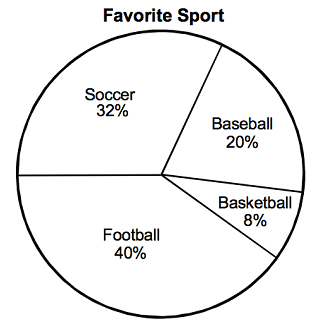
Multiply the proportion by the total to determine how many students each slice represents. The graph shows that 150 students, or 8% of the total, selected basketball as their preferred sport.
8% is represented by the decimal.08, thus multiply 150 by.08 to get 12 students.
For the first 100 students, 8% equals 8 pupils, which may be calculated mentally. For the other 50%, 8% equals 4 pupils. That makes a total of 12 students.
When the y-value is 3, there are two points: (7,3) and (9,3). At these spots, the line crosses the y=3 line.
Only this question cannot be addressed with the provided data because we are unsure of the planting depth of the soil.
The population grows by 20 million every ten years, as shown by the graph. By 2010, the population would have increased by 40 million from its estimated 250 million in 1990.
Using this logic, the sales tax of $85.00 would be almost $8.50 as 8% is about 10%. $8.50 plus $8.00 is a total of $93.50. Peter's target will be slightly more than what he actually requires because of the overestimation in this statement. Peter has to set aside around $93. He needs an additional $58 even though he has roughly $35 in savings. ($93 - $35 = $58).
So, $60 would be the greatest option if it were rounded up. An overestimate is typically more sensible when dealing with money.
Since one gram is equal to 1000 milligrams, the pharmacist possesses 1000 mg. It is possible to utilize proportionate reasoning because each capsule requires 250 mg.
1 cap⁄250mg = xcap⁄1000 mg
Josh will set aside $160, or 5% of $3200, each month. The annual savings are calculated by multiplying by 12.
Advertisement
A mile is one mile if a quarter of an inch is three miles. 2 1⁄3 ÷ 1⁄12 = 28.
2 cups of flour and 1 tablespoon of baking powder yield 4 pancakes; therefore, 1 tablespoon of baking powder yields 4 pancakes. 3 teaspoons of baking powder are required to produce 12 pancakes. Divide 12 by 4 to get the rise in pancakes that corresponds to this. Since the quantity of pancakes is three times that of the recipe's serving size of four, 12/4 = 3, which equals 3 tablespoons of baking powder.
There are 6 hearts on the top row, which equals 120 sold cards. This brings the total number of cards sold to date (550). 240 cards were sold for the 12 hearts in the second row. There are 190 cards sold, or 9 1⁄2 hearts, on the third row. They have sold 550 cards overall.
John is quick to calculate 10% of 40 and double it. Because 10% of 40 is 4 and 4 2 is 8, the correct response in this situation is $8.